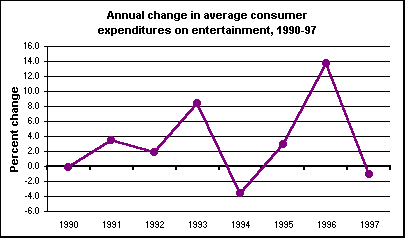An official website of the United States government
 United States Department of Labor
United States Department of Labor
Consumer expenditures on entertainment fell 1.1 percent in 1997, following an increase of 13.8 percent in 1996. Average annual expenditures on entertainment were $1,813 per consumer unit; that figure was less than for basic necessities such as housing, transportation, and food, and about the same as the average for health care.

[Chart data—TXT]
An 8.4-percent decrease in spending on other entertainment supplies, equipment, and services contributed to the overall decrease in entertainment spending in 1997. The subcomponent includes items such as unmotored and motorized recreational vehicles, where relatively small changes in the number of consumers buying such expensive, infrequently purchased items have a large effect on the overall expenditure average.
During 1997, expenditures rose by 2.9 percent for television, radios, and sound equipment and by 2.6 percent for entertainment fees and admissions. However, both of those increases were smaller than the expenditure gains reported in 1996. Spending on pets, toys, and playground equipment decreased 2.4 percent in 1997, after increasing by 4.0 percent the year before.
These data are a product of the BLS Consumer Expenditure Survey. Additional information is available from "Consumer Expenditures in 1997", Report 927.
Bureau of Labor Statistics, U.S. Department of Labor, The Economics Daily, Entertainment spending declines in 1997 at https://www.bls.gov/opub/ted/1999/apr/wk3/art02.htm (visited April 16, 2024).

